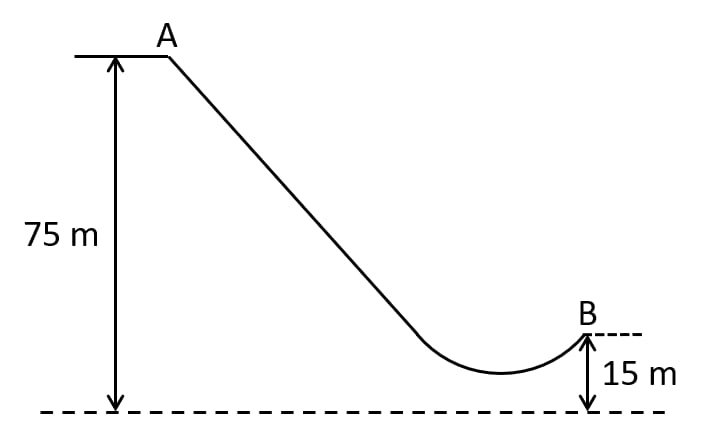Physics
The diagram given below shows a ski jump. A skier weighing 60kgf stands at A at the top of ski jump. He moves from A and takes off for his jump at B.

(a) Calculate the change in the gravitational potential energy of the skier between A and B.
(b) If 75% of the energy in part (a) becomes the kinetic energy at B, calculate the speed at which the skier arrives at B.
(Take g = 10 ms-2).
Work, Energy & Power
68 Likes
Answer
Given,
Mass = 60 kg
(a)
(b) When kinetic energy at B is 75% of (3.6 × 104)
Since,
Kinetic energy = mv2
Substituting the values in equation we get,
∴ The speed at which the skier arrives at B = 30ms-1
Answered By
45 Likes
Related Questions
A stone of mass 500 g is thrown vertically upwards with a velocity of 15ms-1.
Calculate:
(a) the potential energy at the greatest height,
(b) the kinetic energy on reaching the ground
(c) the total energy at its half waypoint.
A metal ball of mass 2kg is allowed to fall freely from rest from a height of 5m above the ground.
- Taking g = 10ms-1, calculate:
- the potential energy possessed by the ball when it is initially at rest.
- the kinetic energy of the ball just before it hits the ground?
- What happens to the mechanical energy after the ball hits the ground and comes to rest?
- Taking g = 10ms-1, calculate:
A hydroelectric power station takes its water from a lake whose water level is 50m above the turbine. Assuming an overall efficiency of 40%, calculate the mass of water which must flow through the turbine each second to produce power output of 1MW. (Take g = 10 m s-2).
The bob of a simple pendulum is imparted a velocity of 5 m s-1 when it is at its mean position. To what maximum vertical height will it rise on reaching at its extreme position if 60% of its energy is lost in overcoming the friction of air?
(Take g = 10 m s-2).